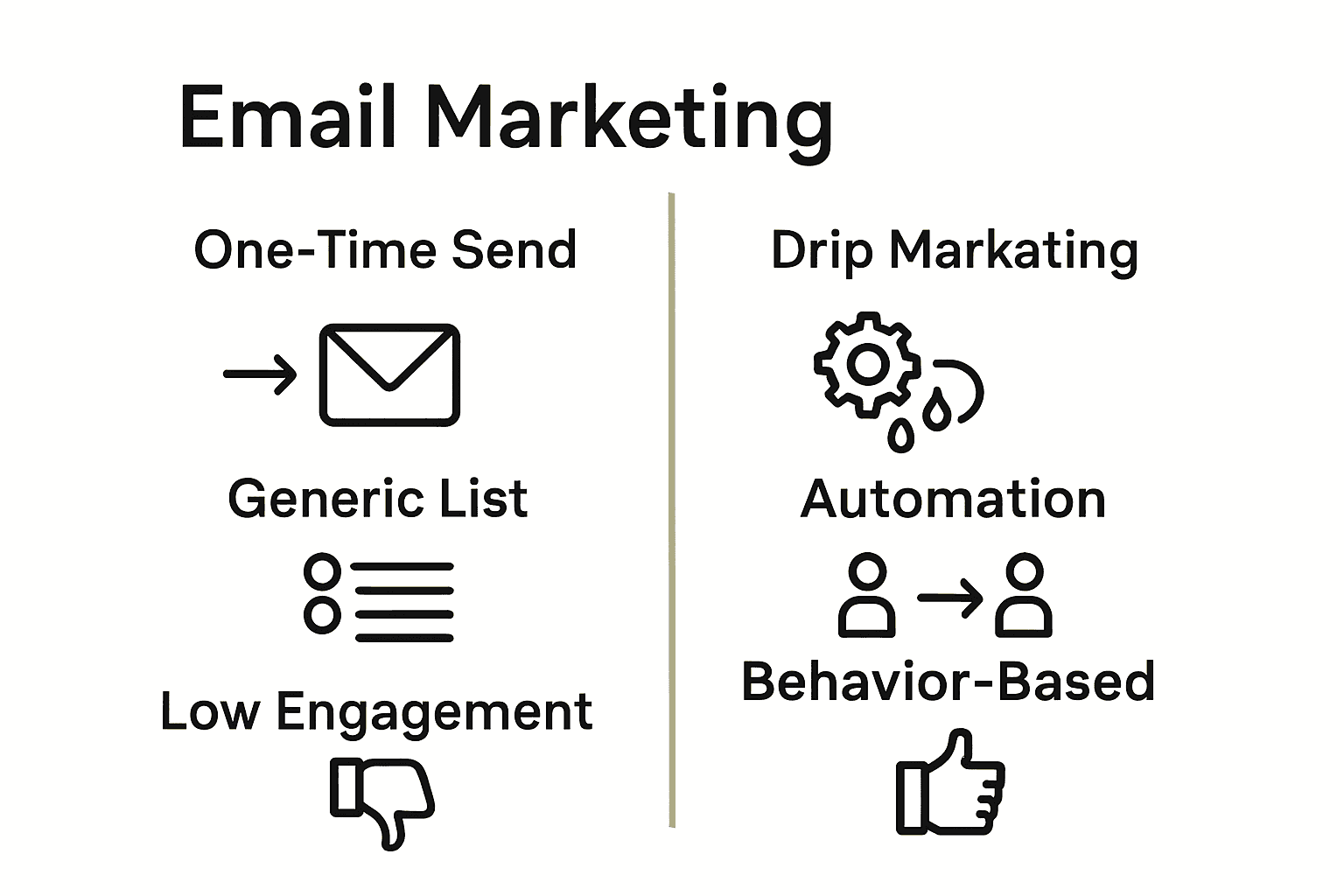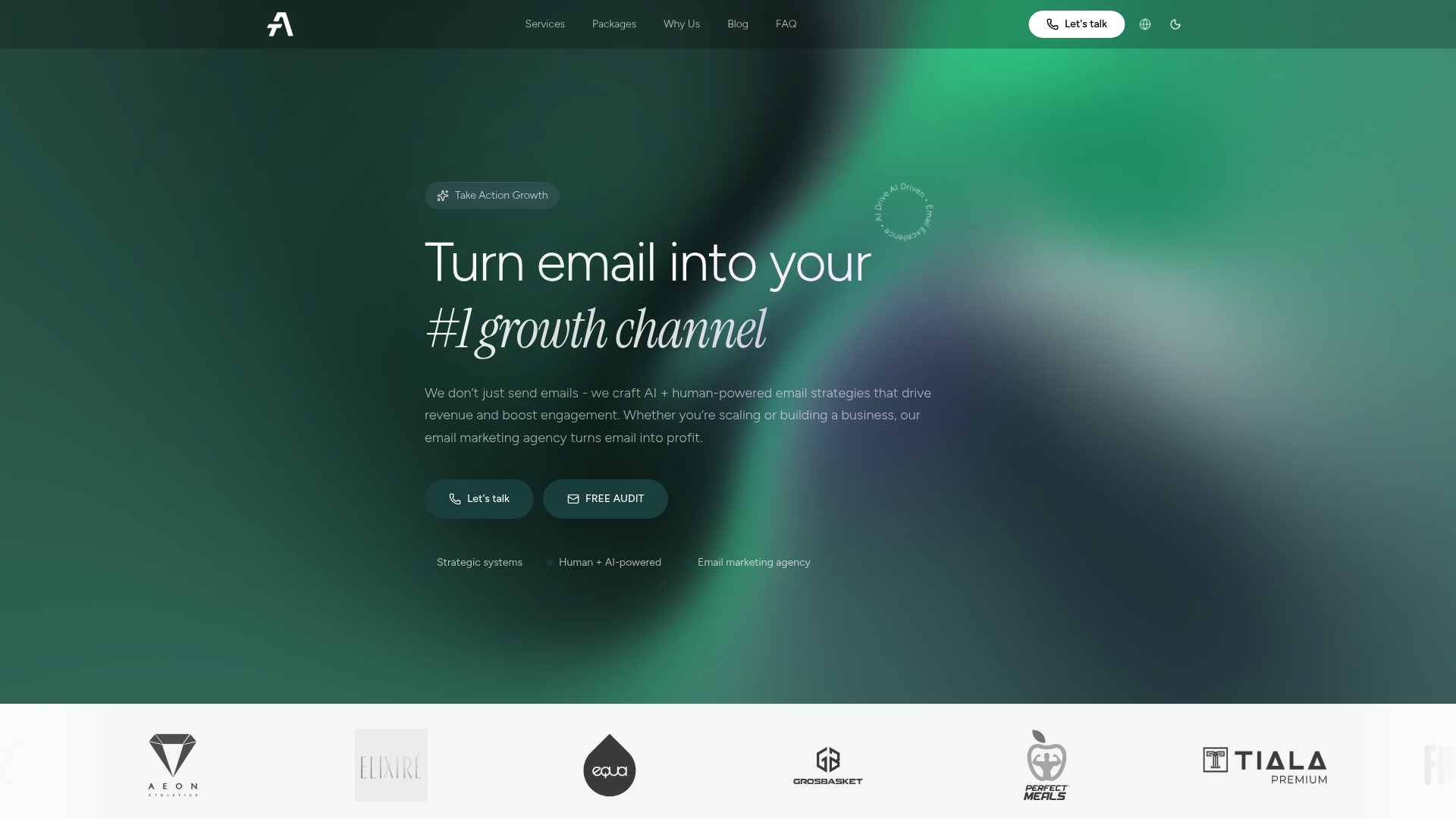Drip Marketing Explained: Complete Guide for Ecommerce
Did you know that automated drip campaigns can lift engagement rates by over 119 percent compared to one-time emails? Brands are changing the way they connect with shoppers, making every message feel timely and personal. With smart automation, businesses replace guesswork and generic blasts with ongoing, tailored conversations. This shift not only draws customers in but also keeps them coming back, turning routine contacts into loyal relationships.
Key Takeaways
| Point | Details |
|---|---|
| Automated Engagement | Drip marketing utilizes automated messaging strategies to deliver personalized content based on customer behavior, enhancing engagement without manual effort. |
| Diverse Campaign Types | Various drip marketing campaigns serve unique purposes, including re-engagement and educational efforts, catering to different customer needs and stages in their journey. |
| Cost Efficiency | Drip marketing is a cost-effective strategy for customer retention, as retaining existing customers is significantly cheaper than acquiring new ones. |
| Avoiding Pitfalls | Brands should avoid overwhelming customers with excessive emails and personalization, ensuring that messaging remains relevant and timely to foster better relationships. |
Table of Contents
- What Is Drip Marketing and How It Works
- Different Types of Drip Marketing Campaigns
- Core Features of Automated Email Flows
- Key Benefits for Ecommerce and DTC Brands
- Common Pitfalls and How to Avoid Them
- Drip Marketing vs Traditional Campaign Emails
What Is Drip Marketing and How It Works
Drip marketing represents a strategic communication approach that transforms how ecommerce brands engage customers through automated, personalized messaging. According to Wikipedia’s definition, drip marketing is a communication strategy that automatically sends pre-written message sequences over time, triggered by specific timing or recipient behavior.
At its core, drip marketing works like a sophisticated digital conversation. Imagine having a marketing assistant who knows exactly when and what to communicate with each customer. These automated campaigns can be triggered by multiple actions:
- Customer sign-ups
- Product purchases
- Abandoned cart events
- Website browsing behavior
- Specific customer segment characteristics
The magic of drip marketing lies in its ability to deliver highly targeted, contextually relevant messages without constant manual intervention. Instead of sending generic communications, these campaigns adapt to individual customer journeys. A new subscriber might receive a welcome series, while a repeat customer could get personalized product recommendations.
Learn more about email automation strategies that can transform how you connect with your audience. By leveraging behavioral data and strategic timing, drip marketing turns routine communications into powerful engagement tools that nurture customer relationships and drive sustainable growth for ecommerce brands.
Different Types of Drip Marketing Campaigns
Drip marketing campaigns are not one-size-fits-all. According to Outbrain, there are six strategic campaign types that ecommerce brands can leverage to create targeted, meaningful customer experiences. Understanding these variations allows businesses to craft precise communication strategies that resonate with different audience segments.
H3: The Six Core Drip Marketing Campaign Types
- Top-of-Mind Campaigns: Keep your brand consistently visible and engaging
- Educational Campaigns: Provide valuable content that builds trust and expertise
- Re-Engagement Campaigns: Reactivate dormant customers or subscribers
- Competitive Campaigns: Strategically position your offerings against alternatives
- Promotional Campaigns: Drive sales through targeted discounts and offers
- Training Campaigns: Guide users through complex products or onboarding processes
Each campaign type serves a unique purpose in the customer journey. A top-of-mind campaign might send periodic newsletters keeping your brand relevant, while an educational campaign could provide step-by-step guides about product usage. Re-engagement campaigns target customers who haven’t purchased recently, offering incentives to return.
Discover more about crafting effective marketing campaigns that transform casual interactions into meaningful customer relationships. By strategically selecting and implementing these drip marketing approaches, ecommerce brands can create personalized experiences that not only attract but also retain customers effectively.

Core Features of Automated Email Flows
Automated email flows transform how ecommerce brands communicate with customers by creating intelligent, responsive communication pathways. According to Salesforce, these flows are personalized and gradual, using behavior-based triggers to send content at relevant customer journey stages, building coherent narratives that develop stronger relationships compared to traditional broadcast emails.
H3: Key Characteristics of Automated Email Flows
- Behavior-Triggered Sequences: Messages sent based on specific customer actions
- Gradual Content Delivery: Strategically timed communications
- Personalization at Scale: Tailored experiences for individual customers
- Adaptive Communication: Flows that respond to customer interactions
According to Salesloop, automated email flows encompass multiple strategic types:
- Onboarding welcome series
- Lead nurture educational sequences
- Abandoned cart recovery
- Post-purchase follow-ups
- Win-back campaigns
The power of these flows lies in their ability to create contextual, relevant interactions that feel personal and timely. Instead of generic mass communications, automated email flows adapt to each customer’s unique journey, delivering the right message at precisely the right moment.
Learn more about marketing automation strategies that can revolutionize your customer engagement. By implementing sophisticated email flows, ecommerce brands can transform routine communications into meaningful, conversion-driving experiences that build lasting customer relationships.
Key Benefits for Ecommerce and DTC Brands
Drip marketing offers ecommerce and direct-to-consumer (DTC) brands a powerful strategy for sustainable growth and customer engagement. According to Braze, these targeted campaigns can dramatically improve customer retention, driving sessions per user by up to 69% compared to non-email outreach strategies.
H3: Primary Advantages for Brands
- Cost-Effective Customer Retention: Significantly cheaper than acquiring new customers
- Personalized Communication: Tailored messaging that resonates with individual customer journeys
- Automated Scalability: Consistent engagement without manual intervention
- Data-Driven Insights: Continuous learning from customer interactions
The economics of drip marketing are particularly compelling. Acquiring a new customer costs 6-7 times more than retaining an existing one, making these automated campaigns a critical tool for sustainable business growth. By focusing on nurturing existing customer relationships, brands can create more predictable revenue streams and build long-term loyalty.
Explore strategic brand positioning techniques that complement your drip marketing efforts. These automated campaigns transform routine communications into strategic touchpoints, enabling ecommerce brands to create meaningful connections, increase customer lifetime value, and build a more resilient, responsive marketing ecosystem.
Common Pitfalls and How to Avoid Them
Drip marketing campaigns can quickly turn ineffective if brands don’t navigate potential challenges strategically. According to Braze, common pitfalls include overwhelming subscribers with excessive emails, creating overly intrusive personalization, sending poorly timed follow-ups, and neglecting regular audience segment adjustments.
H3: Critical Mistakes to Sidestep
- Email Frequency: Bombarding subscribers leads to disengagement
- Personalization Boundaries: Avoid feeling invasive or creepy
- Timing Precision: Ensure messages align with customer journey
- Segmentation Stagnation: Regularly update audience groups
According to Slixta, additional critical mistakes include generic subject lines that trigger spam filters, overwhelming recipients with dense content, and creating unfocused messages without clear calls-to-action. The key is crafting concise, targeted emails with a singular, compelling purpose.
Learn about avoiding branding mistakes that can undermine your marketing efforts. By understanding these potential pitfalls, ecommerce brands can design drip marketing campaigns that feel personal, timely, and genuinely valuable to their audience, transforming potential communication missteps into opportunities for meaningful engagement.
Drip Marketing vs Traditional Campaign Emails
Traditional email campaigns and drip marketing represent two fundamentally different approaches to customer communication. According to Salesforce, traditional campaigns are one-time, generic mass messages, while drip marketing delivers a personalized, sequential narrative aligned to customer behavior, enabling genuine relationship building instead of one-off announcements.
H3: Key Differences Explained
-
Personalization Level:
- Traditional: Generic mass messaging
- Drip Marketing: Highly individualized sequences
-
Sending Mechanism:
- Traditional: Bulk, simultaneous distribution
- Drip Marketing: Behavior-triggered, time-released
-
Customer Engagement:
- Traditional: Minimal and sporadic
- Drip Marketing: Continuous and contextual
According to Braze, drip campaigns are automated, behavior-triggered, and personalized. In contrast, mass emails are generic, sent simultaneously, have lower engagement, minimal personalization, and higher spam risk. Drip marketing consistently outperforms mass messaging for customer nurturing.

Discover email campaign best practices that can transform your communication strategy. By understanding the nuanced differences between traditional emails and sophisticated drip marketing, ecommerce brands can create more meaningful, responsive customer interactions that drive genuine connection and long-term loyalty.
Here’s a comparison of traditional email campaigns and drip marketing:
| Feature | Traditional Email Campaigns | Drip Marketing |
|---|---|---|
| Personalization | Generic, mass messaging | Highly individualized |
| Trigger Mechanism | Manual, scheduled sends | Automated, behavior-based |
| Content Delivery | One-time blasts | Sequential, time-released |
| Customer Engagement | Sporadic, minimal | Continuous, contextual |
| Automation Level | Low | High |
| Spam Risk | Higher | Lower |
Turn Drip Marketing Insights Into Revenue-Driving Action
Are you struggling to make your automated email flows truly connect with your customers? The article uncovered the real challenge for ecommerce brands: it is not just about setting up drip marketing. Success means crafting personalized, strategic automation that boosts customer engagement and converts more sales. Many brands waste time and money on generic campaigns that fail to recover abandoned carts, increase open rates, or build long-term loyalty — even with the latest tools, manual mistakes and lack of segmentation leave revenue on the table.

Now is the time to transform your email marketing from routine messaging into measurable growth. At Take Action, our team combines deep expertise with AI-driven insights to help ecommerce brands master automation, segmentation, and data-backed campaign strategies using Klaviyo. We set up high-performing flows like welcome series, abandoned cart, and post-purchase automations tailored to your brand, so you see higher click rates and sustainable increases in customer retention. Explore how we make email your top revenue channel — discover how our email automation strategies work and start your journey today at Take Action.
Frequently Asked Questions
What is drip marketing?
Drip marketing is a strategic communication approach that involves sending automated, personalized messages to customers based on specific triggers, such as sign-ups or purchase behaviors.
How do drip marketing campaigns work?
Drip marketing campaigns deliver targeted messages over time, adapting to individual customer journeys. They can be triggered by actions like product purchases, website browsing behavior, or abandoned carts.
What are the key benefits of using drip marketing in ecommerce?
Drip marketing offers several benefits, including cost-effective customer retention, personalized communication for enhanced engagement, automated scalability, and the ability to derive data-driven insights from customer interactions.
How does drip marketing differ from traditional email campaigns?
Unlike traditional email campaigns, which often consist of generic, one-time messages, drip marketing focuses on personalized, behavior-triggered communications that are delivered over time, fostering stronger customer relationships and engagement.
Recommended
- What is a Drip Campaign? Understanding Automated Marketing | Take Action Blog | Take Action
- 7 Essential Ecommerce Marketing Strategies for Growth | Take Action Blog | Take Action
- Understanding the Benefits of Email Automation | Take Action Blog | Take Action
- What is Omnichannel Marketing? Understanding Its Importance | Take Action Blog | Take Action
- Maximize Sales with Content Marketing for Ecommerce
